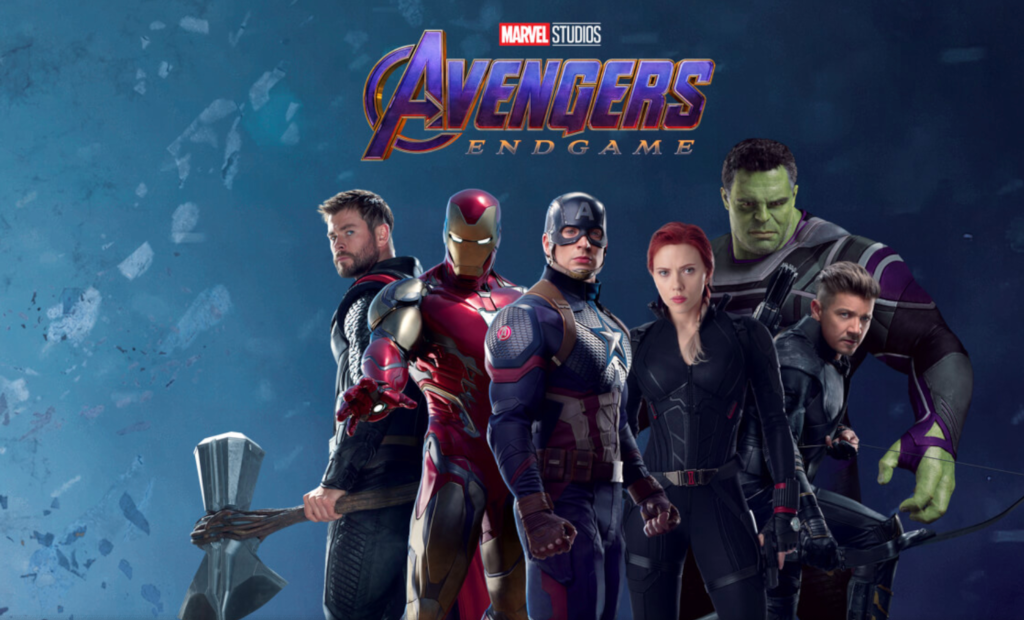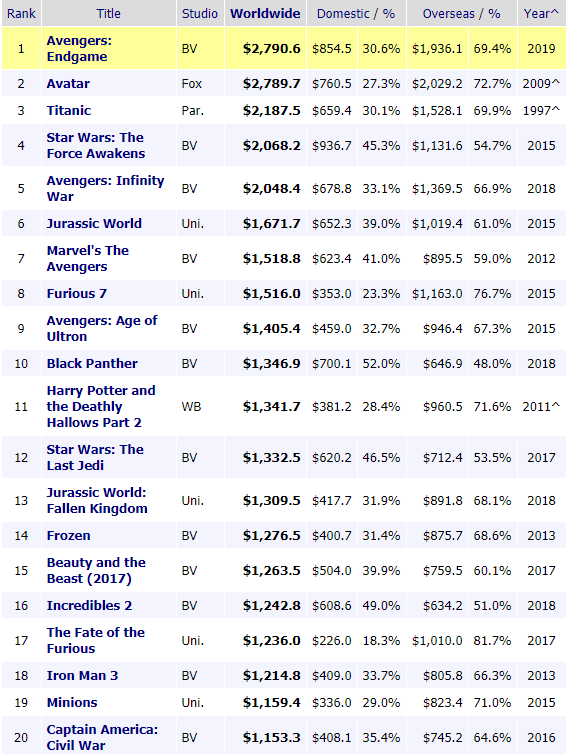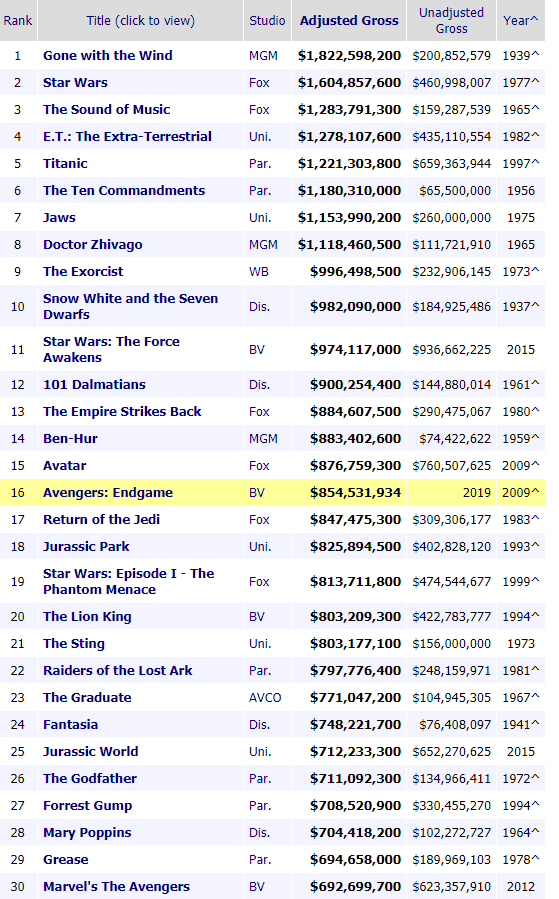Avengers: Endgame Passes Avatar On Top-Grossing Films List
This past weekend, Avengers: Endgame passed Avatar as the biggest-grossing movie of all-time, but there are several caveats.

Over this just-passed weekend, the latest (last?) film in the Avengers saga, Avengers: Endgame passed Avatar as the highest-grossing movie of all time:
LOS ANGELES — The global box office has a new king in “Avengers: Endgame.”
The superhero extravaganza this weekend usurped “Avatar” to become the highest-grossing film of all time, with an estimated $2.79 billion in worldwide grosses in just 13 weeks.
“Avatar” held onto the record for a decade at $2.789 billion.
The title comes with a few caveats, however, including the fact that “Avatar’s” grosses are not adjusted for inflation. Also, domestically, “Avengers: Endgame” is No. 2 to “Star Wars: The Force Awakens” by around $80 million.
As Gizmodo notes, this was very much an internal fight between movie properties owned by the same parent company:
Avengers: Endgame, a movie about a bunch of beautiful superheroes being sad and breaking the timeline, is now the most financially successful movie of all time. It’s been a long road, but we have finally reached the endgame: and really, the winner all along has been Mickey Mouse.
After one theatrical re-release and months at the box office, Avengers: Endgame has officially earned $2.79 billion worldwide, making it the most lucrative theatrical release ever. (At least, if you’re not adjusting for inflation. If you are, it ranks at 16, according to Box Office Mojo, but, still.)
This means that the film, the culmination of a decade of Marvel Studios filmmaking and hype, has edged out Avatar—a franchise that Disney now also owns after its acquisition of Fox earlier this year—from its decade-long reign as the top-grossing film, with $2.789 billion.
This is obviously a huge deal for Marvel—it’s a validation of their dominance of the cultural sphere, a monument to what you can do with the resources of one of the largest media monopolies ever behind you. It’s also, frankly, a handy receipt that more than lets you get away with managing to bring down Hall H at Comic-Con with the announcement that Angelina Jolie will play an obscure Jack Kirby character basically created as a riff of other obscure characters Kirby created for Marvel’s comics rival, DC Comics. It also seems to be a big deal to fans, for reasons I don’t quite understand, as many have been rooting excitedly for this to happen for a while. Brand loyalty is a hell of a drug, I suppose.
What this means going forward is probably a lot more Marvel movies, with as much money and talent behind them as Disney can muster. It also probably means that, somewhere, today, James Cameron is probably working on one of several Avatar sequels, feeling just a teeny little bit annoyed. Maybe you’ll get ’em next time, James. For now, the Avatar twitter decided to be a bit more diplomatic, sharing a message including the bizarre imagery of Iron Man being fondled by Pandoran fauna:
(…)
Box Office Mojo reports that despite lackluster critical appraisal, Jon Favreau’s CG remake of the beloved animated classic The Lion King raked in a record-setting $185 million in its opening weekend. The movie takes the record for the best July opener from Harry Potter and the Deathly Hallows Part 2—a movie in a franchise that Walt Disney has somehow yet to acquire, but would probably really like to—which it had held since 2011.
What does that mean? Well, that we can likely expect Disney to continue to chew through its ’90s animated renaissance with a reckless abandon for remakes. Aladdin and The Lion King already came and went this year, with the upcoming Mulan and the currently–casting The Little Mermaid already on the way. How long until the decidedly uncomfortable idea of a Pocahontas remake gets announced?
In fact, if you look at the chart of the top-grossing films, you notice something that is likely to have Mickey Mouse, and Disney CEO Bob Iger, smiling:

Each movie with “BV” in the studio column is a Disney-owned property, and Disney now owns three of the top-grossing franchises in movie history, the Marvel Cinematic Universe, the Star Wars franchise, and, thanks to its acquisition of Twentieth-Century Fox’s production business, the Avatar franchise, which will include at least three planned sequels in the coming years. The mouse is doing pretty good, apparently.
Of course, things are much different if you adjust things for inflation. Here’s the list that Box Office Mojo has up at the current time:

On this list, Avatar sits at 15th place in the top 20 while Avengers:Endgame sits just behind it at 16th place. More significant perhaps is the fact that there isn’t a single movie from the 21st Century in the top ten notwithstanding the fact that we’ve seen plenty of incredibly high grossing movies over the past 19 years.. Additionally, the most recently released movie in the top ten, 1997’s Titanic, was released twenty-two years ago. To find a movie from the last 20 years you have to go to 11th place, which is currently occupied by the seventh movie in the Star Wars saga, The Force Awakens. In fact, there are only four movies from the 21st century in the Top 25 list, The Force Awakens, Avatar, Avengers: Endgame and Jurassic World.
This comparison is, of course, somewhat arbitrary. For one thing, the movie business has changed significantly since 1939 when Gone With The Wind was released. There are far more movie theaters today than there were 80 years ago, for example, and most of those theaters have more than one screen, meaning that the same movie can be shown in multiple theaters at the roughly the same time and more people can see it without having to wait for the theater to be available for the next showing. On the opening weekend for Avengers: Endgame, for example, there were many multiplexes where the film was being shown on all, or nearly all, of the available screens in one theater. This obviously meant that more people could see it on opening weekend and the movie’s gross box office receipts would reflect that. Additionally, the fact that there are now multiple formats in which a movie can be shown, such as 3-D, IMAX and other similar formats, and that many of these formats charge different prices from a “regular” screening means that a movie released in this era has a chance to make huge amounts of money just because of the format in which it was released. Finally, movies today are judged by their worldwide receipts, something that was not even a factor in the movie business until about the 1990s or so.
Another factor to keep in mind is that Hollywood has strange rules that determine whether or not a movie is profitable. In some cases, this has led to litigation between studios and those who signed contracts that give them certain percentages of receipts net of expenses. To put it mildly, these lawsuits have shown that the accounting rules in Hollywood are a bit different than what you might find in the business world.
So when you hear about the records that Endgame is setting, remember that comparing those numbers to the money earned by Gone With The Wind, Ben-Hur, or The Godfather is like comparing apples and oranges.






Hot Take: Gone with the Wind should be seen the same way Birth of a Nation is. Interesting perhaps from an academic perspective on the history of the film media, but not from an artistic standpoint.
And speaking of apples and oranges, that first list you posted is of worldwide grosses. The adjusted one is merely domestic. In adjusted gross, GWTW earns less than the international BO of Endgame. So the question is now what is the international success of Gone With The Wind? Because if it’s not running over $800 million adjusted (to match Endgame’s domestic haul) — and I suspect that a movie released in 1939 probably did less well than that, given how international distribution has changed — it’s quite possible that Endgame has actually grossed more than Gone With The Wind.
Of course, GWTW only cost a little less than $4 million to make, and Endgame cost somewhere north of $350,000,000. So calculate this as you like…
@Stormy Dragon: “Interesting perhaps from an academic perspective on the history of the film media, but not from an artistic standpoint.”
I think this is kind of backwards. Birth of a Nation was a tremendous leap forward creatively — I don’t think there was anyone who didn’t consider Griffith one of the most important forces in the development of the artform. The troubles with the movie now all spring from its politics and morality, not its filmmaking aesthetics. If it weren’t such a powerful piece of filmmaking it would have been forgotten decades ago…
Not adjusting for inflation renders the whole exercise as meaningless as comparing the cost of one thing in US dollars and another in Canadian dollars. (CAD currently about 75 cents, but in 2011 there was parity.) In fact, it’s even harder to compare. When GWTW came out the US population was only 40% what it is now and I suspect that international grosses were not even counted at all. Today the international gross for a blockbuster is easily twice what the US gross is.
@wr: $3.9 in 1940 = $71 today.
@wr:
I think we fundamentally agree on why it’s a bad movie, but I see the politics and morality as a fundamental component of the “filmaking aesthetics” and you see them as extraneous historical baggage.
The merchandising value of some of these movies can bring in a lot of money. I have seen a lot of “Avengers” t-shirts. The “Frozen” merchandise income was out the roof – probably a $ billion easily. Everywhere I went it was “Frozen” cups, ink pens,
book marks, lanyards,pencils, and throws. You could find that stuff in outer Mongolia or a convenience store in the low country of SC. Disney made enough money off that movie to let people in free to Disney World for a year and not miss a dime. “Frozen 2” is coming.
How big were movie theaters 80 years ago?
Up til the 90s, gigantic theaters were still common in Mexico City. I mean huge theaters with screens as tall the side of a building and hundreds of seats available.
They’re all gone. A few were converted to multiplex theater (are they still called that?), some were torn down, most were converted to other uses, like office supply stores (really) and at least one was turned into a stage theater.
I miss them. Sure, image quality is better today (it was fine in the 80s), and sound is incomparably superior (no contest at all), and you get seat-side service, and cup holders, and the VIP/premium theaters are really nice. But you don’t get the effect now of seeing the Death Star look as big as the Moon, even if you seat at the front row.
But, given there are also many more movies now, the One HUGE Theater model was not sustainable, even had they upgraded image and sound and service.
I’ve said it before, and I’ll say it again: the Hollywood press ignores inflation because it enables them to claim box-office records are being broken more often. They wouldn’t be able to hype as many movies if they were being economically literate.
@Stormy Dragon: My wife and I last saw GWTW in a theater re-release in the mid-seventies. I was afraid we were going to get kicked out. We were getting really dirty looks for laughing in the wrong places.
@Kathy:
IIRC, the shift to more smaller theaters in the US was driven largely by the Americans with Disabilities Act. I forget the specifics, but there was some sort of cutoff where theaters with more than a certain number of seats required a big jump in accommodations, and nearly all theaters built after that were sized just under the cutoff.
@Kathy: Good point. And those huge theaters existed because everyone went to the movies, regularly. Less competition for a families entertainment dollars.
@Tyrell: “Gone With The Wind” really didn’t do as well with the merchandising as “Avengers” or “Frozen”, did it?
But, “Birth Of A Nation” went all out with the merchandising. Nearly a hundred years later, my brothers still have their costumes and go to the conventions… they are such nerds.
@gVOR08:
Oh, yeah. I recall seeing a lot of movies I didn’t care to see, because “we’re going to the movies.”
@Stormy Dragon:
That sounds plausible, but there must be more to it than that.
The big theater was the standard in Mexico in the 70s, but there were smaller ones. a chain had multiplexes with 4 to 5 theaters in shopping malls. There were also “Art House” theaters part of another chain, I think, which were small, intimate even, and showed more highbrow fare, often older movies or ones that were not big hits. Some of these had two theaters. as an aside, these theaters were all named after film directors; with names like Goddard and Kubrick.
By the 80s, small theaters, usually with two screens, began to sprout in smaller shopping malls. In the 90s Cinemark opened a modern theater with half a million screens and large tubs of popcorn. Then local companies copied the model, and that’s where things stand today.
@Kathy: The large theaters were better. You had plenty of room and the screen size gave a great experience. The cameras used to film the movies went from 35 millimeter film width to 70 mm: “Super Technirama Technicolor”. And the tickets were fifty cents or so for adults, and popcorn did not cost $10 like it does now. Some of the theaters had balconies. I enjoyed sitting up there.
Theaters got smaller and not as exciting. The other recent change is from film to digital projection. Some of the drive-in theaters around here closed because they could not afford the new digital projectors.
Watching “Lawrence of Arabia” on the big screen: nothing like it.
@Tyrell: Dunkirk was largely shot in 65mm IMAX, and with old school special effects, little or no CGI. When they needed a WWII destroyer, they found a mothballed French destroyer. When they had a dogfight scene between a Spitfire and an Me 109 they got a flyable Spitfire and Buchon, a Spanish built 109 with, ironically, a Rolls Royce Merlin engine like the Spitfire. They also built the Yakfire, an old Russian trainer dummied up so the view from the cockpit, through the gunsight, looked like a Spitfire. The aerial work was apparently a real pain as the IMAX cameras only carry a few minutes worth of film.
If you ever get the chance, see it in an IMAX theatre.
There’s no really meaningful way to compare films from different eras. We simply make far, far movies today and viewers have many more options.
Through the 1950s, the only way to see a movie was in a theater. So people went to the theater a lot.
Gradually, television and especially cable television started showing the movies in our homes—but you had to wait quite a while. And we started being able to buy movies on video, laserdisc, DVD, Bluray, etc. And then streaming services. All of that cuts into sales at the theater.
Indeed, the only movies I regularly watch in theater are things like the Marvel and Star Wars flicks—where the bigger screen and dynamic sound effects make a huge difference—or movies aimed at children, where seeing them right away is part of a family experience. Your average drama or comedy? I’d much rather watch it in the comfort of my home on a 60-inch HD screen.
@Stormy Dragon: “IIRC, the shift to more smaller theaters in the US was driven largely by the Americans with Disabilities Act.”
I don’t know where you’re getting this from, but I’ve never heard any mention of it. It sounds like some bizarre libertarian, anti-government obsession. The economic force behind multiplexing was the realization that theater owners could more efficiently use a set of employees by having multiple shows at staggered times, thus keeping box office and concession sales going continuously, rather than paying the workers to be essentially idle for two hours at a time. Also it was a hedge against a flop — with more than one title playing, they could keep concession sales flowing even if one auditorium was essentially empty.
Someone the other day advised listening to me re: the business of writing because I get paid to write. Much the same with @wr. He’s in the TV/movie biz and he gets paid. Probably knows more than most of us do.
@wr:
Aha, I was right, I find a reference to the cutoff in Lonberg vs. Sanborn Theaters. In the 1991 ADA new contruction guidelines (28 C.F.R. pt. 36, App. A, §§ 4.33.3), it was specified:
As you can see, this creates a huge incentive to limit all of your movie theaters to less than 300 seats, so you only have to make one part of the theater wheelchair accessible, vs more than 300 seats, where you now have to make multiple parts of the theater accessible.
@Stormy Dragon: Yes, that’s in the law. However it doesn’t go at all to show that theaters turned to multiplexes BECAUSE of it, which is what you were claiming.
Also, “making parts of the theater wheelchair accessible” in real life generally means taking out one or two seats at the end of an aisle. So I really doubt anyone was dying to build that 900-seat theater but then decided to multiplex to avoid having to put in two more spaces for wheelchairs.
@wr:
It’s not the wheelchair spaces, it’s that the spaces must have ramps to get to them and ramps to an emergency exit. If you have less than 300 seats, you can put all the wheelchair spots together and build one set of ramps to them. Once you pass 300, you have to spread them out throughout the theater, which means multiple ramps are now required.
And you’re right it probably doesn’t make a difference between 3 300 seats theaters and 1 900 seat theater, but it may make the difference between 12 300 seat theaters (12 sets of ramps) and 9 400 seat theaters (at least 18 sets of ramps). The two complexes have the same total capacity, but the later requires 50% more spent on accommodations.
@gVOR08: ” Good point. And those huge theaters existed because everyone went to the movies, regularly. Less competition for a families entertainment dollars.”
Or even smaller theaters, back in the ‘Gone with the Wind’ days. Presumably everybody in town saw that, on the one screen in town, during the month (or two, three,…?) it was being shown.
@Stormy Dragon: Have you ever been in an American theater? What you’re describing simply does not exist. You don’t need “ramps” to the seats because in just about every movie theater the aisles already ARE ramps.
This is such a silly conversation, seemingly sparked by an inherent loathing of anything governmental. Just buy a ticket and go into any auditorium in your local multiplex and you will see that what you are spinning is a ludicrous Ayn Rand-style fantasy about what is required.
And again — you offer absolutely no evidence that this demand caused the move towards multiplexing or was even a minor consideration. You seem to assume that everyone in the world is simply horrified at the idea of accommodating the handicapped and will ignore all other business considerations to avoid doing so… but you’ve got nothing to back you up other than your assumption.
@wr: ” The economic force behind multiplexing was the realization that theater owners could more efficiently use a set of employees by having multiple shows at staggered times, thus keeping box office and concession sales going continuously, rather than paying the workers to be essentially idle for two hours at a time.”
And I always see that blockbusters are screened every half-hour from noon until 9PM (or later) at my local 16-screen theater.
I will look for disability accommodations in smaller rooms next time; my recollection is that they all have them now.
From my casual architectural observation, the large theaters run a *lot* of screens from a small area, as well. I imagine that the customer:projector personnel ratio is far higher.
@Stormy Dragon: “It’s not the wheelchair spaces, it’s that the spaces must have ramps to get to them and ramps to an emergency exit. If you have less than 300 seats, you can put all the wheelchair spots together and build one set of ramps to them. Once you pass 300, you have to spread them out throughout the theater, which means multiple ramps are now required.”
At my local theater, all rooms have ramps.
@wr:
Bullshit. Theaters today are almost all stadium seating where nearly all the seats require you to walk up or down steps.
@wr:
No more than you’ve offered any evidence for your assertion that theater size was driven by popcorn sales. We’re both speculating.
I’m accusing theaters of mistreating their disabled customers to save money. How is that an Ayn Rand fantasy?
@gVOR08: Thanks for the interesting information. I went to Imax once, and I started getting motion sickness because they were showing POV theme park rides. I will watch out for “Dunkirk” when they show it around here. When I was a child I would go to the projection booth and watch them run the 35 mm. projectors. While in school I would help load the 16mm Bell and Howell. VHS came out and doomed the home movie film cameras and school projectors. You can get a projector on line fairly cheap. The problem is finding the movies.
I have heard that Kodak still makes some movie film.
@Tyrell: Film projection is still used at some theaters. There was no “CHANGE HARDWARE TO DIGITAL OR CLOSE”…..
Here’s an example of an imax film being loaded.
https://www.youtube.com/watch?v=_uFyp1WS1Fw